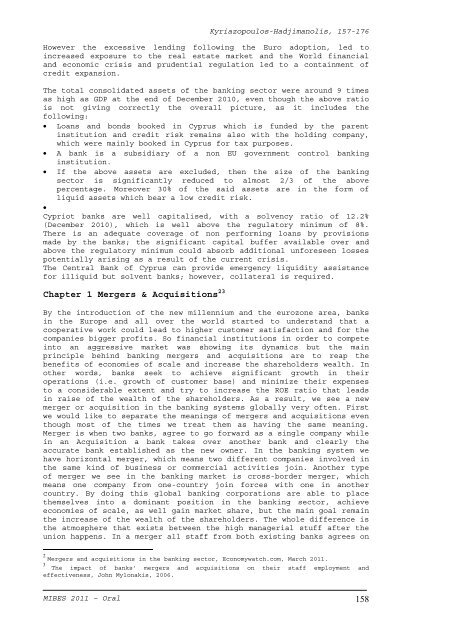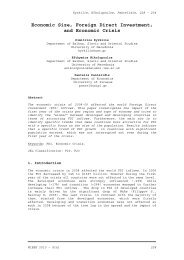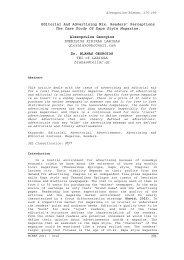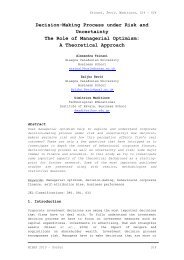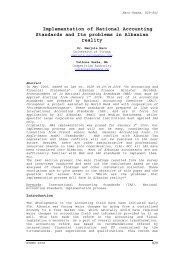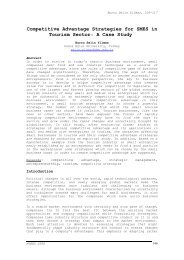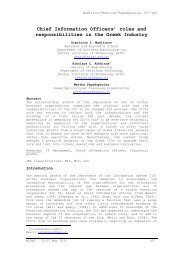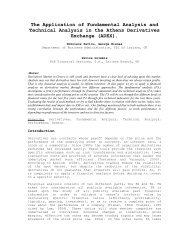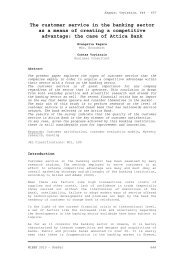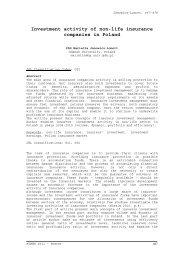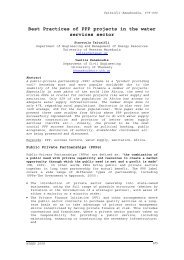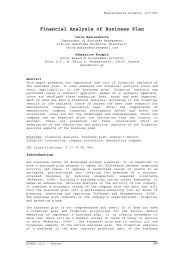Du Pont Analysis of a Bank Merger and Acquisition between ... - mibes
Du Pont Analysis of a Bank Merger and Acquisition between ... - mibes
Du Pont Analysis of a Bank Merger and Acquisition between ... - mibes
Create successful ePaper yourself
Turn your PDF publications into a flip-book with our unique Google optimized e-Paper software.
Kyriazopoulos-Hadjimanolis, 157-176<br />
However the excessive lending following the Euro ad<br />
increased exposure to the real estate market <strong>and</strong> th<br />
<strong>and</strong> economic crisis <strong>and</strong> prudential regulation led t<br />
credit expansion.<br />
option, led to<br />
e World financial<br />
o a containment <strong>of</strong><br />
The total consolidated assets <strong>of</strong> the banking sector were around 9 times<br />
as high as GDP at the end <strong>of</strong> December 2010, even th ough the above ratio<br />
is not giving correctly the overall picture, as it includes the<br />
following:<br />
• Loans <strong>and</strong> bonds booked in Cyprus which is funded by the parent<br />
institution <strong>and</strong> credit risk remains also with the h olding company,<br />
which were mainly booked in Cyprus for tax purposes .<br />
• A bank is a subsidiary <strong>of</strong> a non EU government contr ol banking<br />
institution.<br />
• If the above assets are excluded, then the size <strong>of</strong> the banking<br />
sector is significantly reduced to almost 2/3 <strong>of</strong> th e above<br />
percentage. Moreover 30% <strong>of</strong> the said assets are in the form <strong>of</strong><br />
liquid assets which bear a low credit risk.<br />
•<br />
Cypriot banks are well capitalised, with a solvency ratio <strong>of</strong> 12.2%<br />
(December 2010), which is well above the regulatory minimum <strong>of</strong> 8%.<br />
There is an adequate coverage <strong>of</strong> non performing loa ns by provisions<br />
made by the banks; the significant capital buffer a vailable over <strong>and</strong><br />
above the regulatory minimum could absorb additiona l unforeseen losses<br />
potentially arising as a result <strong>of</strong> the current cris is.<br />
The Central <strong>Bank</strong> <strong>of</strong> Cyprus can provide emergency li quidity assistance<br />
for illiquid but solvent banks; however, collateral is required.<br />
Chapter 1 <strong>Merger</strong>s & <strong>Acquisition</strong>s<br />
23<br />
By the introduction <strong>of</strong> the new millennium <strong>and</strong> the e urozone area, banks<br />
in the Europe <strong>and</strong> all over the world started to und erst<strong>and</strong> that a<br />
cooperative work could lead to higher customer sati sfaction <strong>and</strong> for the<br />
companies bigger pr<strong>of</strong>its. So financial institutions in order to compete<br />
into an aggressive market was showing its dynamics but the main<br />
principle behind banking mergers <strong>and</strong> acquisitions a re to reap the<br />
benefits <strong>of</strong> economies <strong>of</strong> scale <strong>and</strong> increase the sha reholders wealth. In<br />
other words, banks seek to achieve significant grow th in their<br />
operations (i.e. growth <strong>of</strong> customer base) <strong>and</strong> minim ize their expenses<br />
to a considerable extent <strong>and</strong> try to increase the RO E ratio that leads<br />
in raise <strong>of</strong> the wealth <strong>of</strong> the shareholders. As a re sult, we see a new<br />
merger or acquisition in the banking systems global ly very <strong>of</strong>ten. First<br />
we would like to separate the meanings <strong>of</strong> mergers a nd acquisitions even<br />
though most <strong>of</strong> the times we treat them as having th e same meaning.<br />
<strong>Merger</strong> is when two banks, agree to go forward as a single company while<br />
in an <strong>Acquisition</strong> a bank takes over another bank an d clearly the<br />
accurate bank established as the new owner. In the banking system we<br />
have horizontal merger, which means two different c ompanies involved in<br />
the same kind <strong>of</strong> business or commercial activities join. Another type<br />
<strong>of</strong> merger we see in the banking market is cross-bor der merger, which<br />
means one company from one-country join forces with one in another<br />
country. By doing this global banking corporations are able to place<br />
themselves into a dominant position in the banking sector, achieve<br />
economies <strong>of</strong> scale, as well gain market share, but the main goal remain<br />
the increase <strong>of</strong> the wealth <strong>of</strong> the shareholders. The whole difference is<br />
the atmosphere that exists <strong>between</strong> the high manager ial stuff after the<br />
union happens. In a merger all staff from both exis ting banks agrees on<br />
2 <strong>Merger</strong>s <strong>and</strong> acquisitions in the banking sector, Eco nomywatch.com, March 2011.<br />
3<br />
The impact <strong>of</strong> banks’ mergers <strong>and</strong> acquisitions on th eir staff employment <strong>and</strong><br />
effectiveness, John Mylonakis, 2006.<br />
MIBES 2011 – Oral 158


